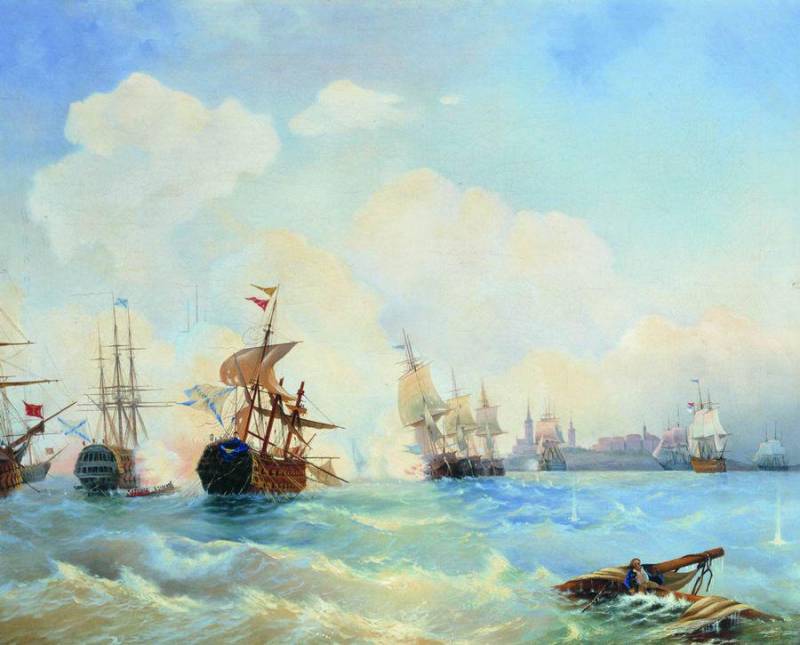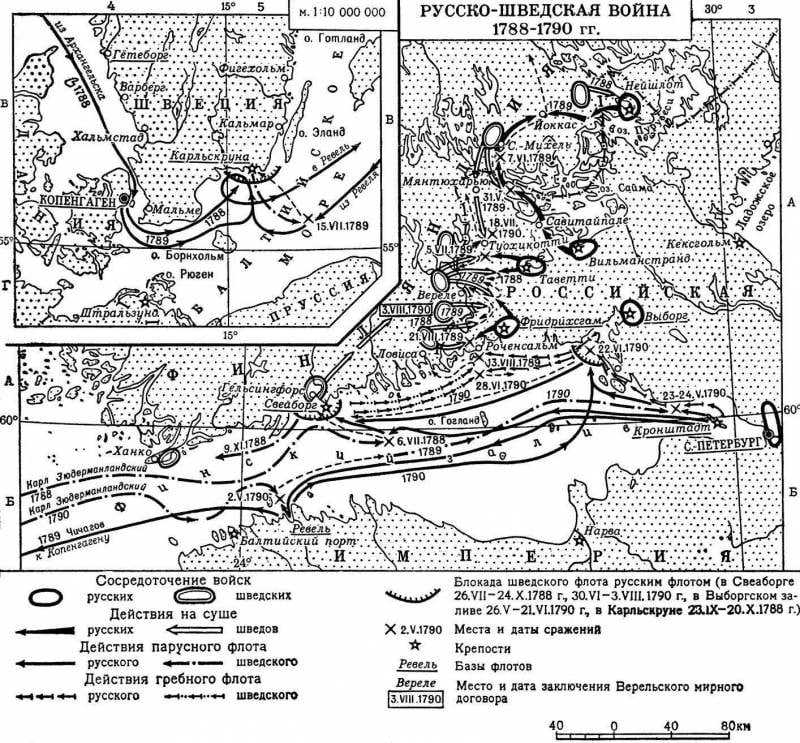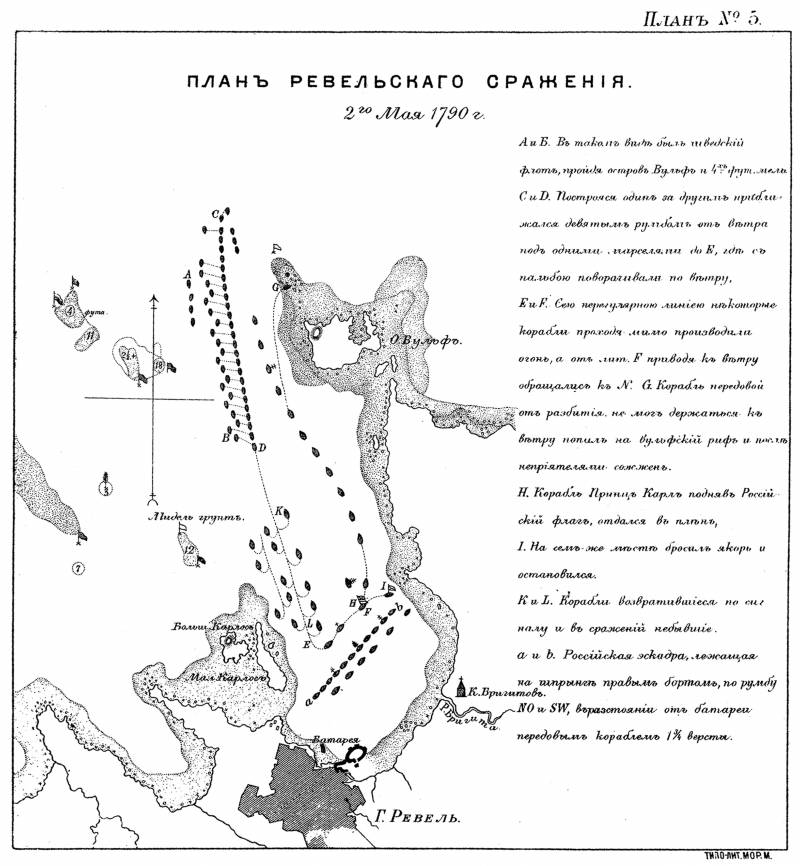The defeat of the Swedish fleet in the battle of Revel
Russian-Swedish War 1788 — 1790 230 years ago, in May 1790, the Revel naval battle took place. The Russian squadron under the command of Chichagov defeated the superior forces of the Swedish fleet.
"To Petersburg"
The Swedish monarch Gustav III, despite the failures of 1788-1789, financial problems, the ruin of the economy and public discontent with the war, decided to attack in 1790. The Swedish High Command, as in 1788, was planning a “lightning war”. On land, the army under the command of the king himself, generals von Stedingk and Armfelt, was to defeat the Russian troops and develop an offensive on Vyborg, creating a threat to St. Petersburg.
In the meantime, the Swedish fleet was supposed to attack and defeat the parts of the Russian ship and rowing fleet scattered in Revel, Friedrichsgam, Vyborg and Kronstadt. Then it was possible to land troops in the Vyborg area, which was supposed to support the advance of the ground forces. The Swedes had a numerical superiority at sea and hoped for success. Thus, King Gustav wanted to quickly defeat the Russian armed forces in the northwest, create a threat to the Russian capital from land and sea, and force Empress Catherine II to make peace in Sweden.
However, the Swedes could not organize coordinated actions of the army, rowing and ship fleet. On land in April — May 1790, several battles of local importance took place (The defeat of the Russian army in the battle of Kernikoski), where success was on the side of the Swedes, then the Russians. The Swedes had no superior either in the number of troops, nor in their quality. The Swedes could not defeat the Russian army and break through to Vyborg. The Swedish fleet attacked the Russians, but the matter was also limited to a series of battles that did not lead to a decisive victory for Sweden.
Plans and forces of the parties
At the end of April 1790, when the Russian squadron in Kronstadt was just preparing to go to sea, the Swedish fleet left Karlskrona. On May 2 (13), 1790, the Swedes were at Fr. Nargena, hoping for surprise. However, the Russians learned about the appearance of the enemy from the crew of a neutral vessel, which arrived in Revel and prepared for battle. In the morning, the commander of the Russian squadron, Admiral Vasily Chichagov, gathered flagships and captains and gave a short speech, urging everyone to die or glorify themselves and the Fatherland.
The Russian squadron under the command of Vasily Chichagov stood on the Revelsky roadstead, in the direction from the harbor to the shallows of Mount Vimsa. In the first line there were nine battleships and a frigate: Rostislav and Saratov (100 guns each), Cyrus John, Mstislav, St. Helena and Yaroslav (74 guns), Victorious Boleslav and Izyaslav (66 guns), frigate Venus (50 guns). In the second line there were four frigates: “Podrazislav”, “Glory”, “Hope of Well-Being” and “Pryamislav” (32 to 36 guns each). On the flanks there were two bombing ships - “Terrible” and “Winner”. In the third line there were 7 boats. The vanguard and rearguard were led by Vice Admiral Alexei Musin-Pushkin and Rear Admiral Pyotr Khanykov.
The Swedish fleet was under the command of the brother of King Duke Karl of Södermanland (the spelling of Karl Südermanland is also common in Russian tradition). There were 22 ships (armed with 60 to 74 guns), 4 frigates and 4 small vessels. That is, the Swedes had a double superiority in forces and could count on victory over part of the Russian fleet. The Swedish command decided to fight in motion, walking in a wake column and firing at Russian ships. And repeat this maneuver until the Russians are defeated. This "run through the ranks", in the words of the German researcher Stenzel, was a big mistake. The Swedes could not use their numerical advantage, did not anchor in front of the Russians to fire with them, where they would gain superiority due to the number of ships and guns. They didn’t try to get around the Russian squadron, to get closer, etc. In conditions of strong wind and inaccurate sight, the Swedes fired poorly. A strong wind tilted the Swedish ships to the side with which they acted against the enemy. Russian ships, anchored, fired better.
Revel battle
With an increasing westerly wind and noticeable unrest, the enemy fleet linearly entered the raid. The advanced Swedish ship, having caught up with the fourth-rank captain Sheshukov, the fourth ship from the left flank of the Russian line Izyaslav, lay down on the left tack and fired a volley. However, due to a strong roll and poor sight, most of the shells passed by the Russian ship. The Russians, however, fired more accurately and harmed the enemy. The situation was similar in the future. The leading Swedish ship, which quickly passed along the line towards the Wulf island, was followed by the rest of the Swedes.
Some Swedish commanders showed courage and tried to come closer, to reduce sails and roll, they reduced sails. They were met by sighting salvos and suffered more casualties in people and serious damage to the mast (device for setting sails) and rigging (all tackle of the ship). However, they could not cause serious damage to the Russian ships. The ship of the Swedish admiral "King Gustav III" was especially damaged. He was carried to the Russian 100-gun flagship "Rostislav", which fired at the enemy from close range. Another Swedish ship, Prince Karl, which went 15th in line, having lost part of the mast, dropped the anchor after a 10-minute battle and raised the Russian flag.
The Swedish commander, the Duke Karl, watched the battle from the side of one of the frigates and was outside the zone of effective fire of the enemy. After two hours of shooting, the Duke of Södermanland ordered the battle to end. As a result, the last 10 ships of the Swedish fleet, without entering into battle, went north.
The Swedish 60-gun ship Raksen-Stender was damaged and landed on a reef north of Wulf Island. The Swedes could not remove the ship and burned it so that it would not go to the enemy. Another Swedish ship before the start of the battle ran aground north of the island of Kargen. He was taken aground, but most of the guns had to be thrown into the sea.
Thus, the Battle of Revel became the complete victory of the Russians. With almost double superiority, the Swedes could not achieve victory, destroying part of the Russian fleet. The Swedish fleet lost two ships and retreated. The losses of the Swedish side amounted to about 150 people killed and wounded, 250 (according to other sources - 520) were captured. Russian losses - 35 killed and wounded. After the battle, the Swedes partially put their ships in order in the sea and moved east of the island of Hogland. Several ships went for repairs in Sveaborg. It was a strategic victory for Russia, the Swedish campaign plan of 1790 was disrupted. They could not destroy the Russian fleet in parts. The combat effectiveness of the Swedish fleet decreased.
Friedrichsham battle
Meanwhile, another battle at sea occurred - the battle of the rowing fleets at Friedrichsham. After several setbacks on land, the Swedish king Gustav decided to switch to a rowing fleet in order to attack the Russians in Friedrichsham. Thus, the Swedish ruler hoped to distract the Russian troops from other directions and to ease the position of the troops of generals Stedingk and Armfelt, who should invade Russian Finland.
The Swedes had a chance of success. In early May 1790, the entire Swedish galley fleet was off the coast of Finland. Most of the Russian galley fleet was at Kronstadt and St. Petersburg. The winter of 1790 was warm, but in the spring it did not recede for a long time. There was a lot of ice in the skerries. An advanced Russian rowing flotilla squad under captain Slizov wintered in Friedrichsgam Bay. It included 3 large and 60 small vessels. Despite the outbreak of hostilities, the squadron's armament has not yet been completed. Many gunboats did not have full weapons and ammunition. The detachment had only half the crew. Yes, and he consisted mostly of peasants who, at best, had ever walked along rivers. But the biggest problem was the lack of ammunition. In addition, the commander of the rowing flotilla, Prince Nassau-Siegen, did not accept Slizov’s proposal to strengthen the position with coastal batteries, the construction of which seemed to the French naval commander premature.
Being in a vulnerable position, on May 3 (14), 1790, Slizov learned about the approach of an enemy fleet, which consisted of 140 combat ships and 14 transports. The Russian squad lined up at the entrance to the bay. On May 4 (15), the Swedes attacked in the early morning. Letting the enemy close range, Sliz opened fire from all the cannons. The stubborn battle lasted about 3 hours. The right wing of the Swedish rowing fleet was already flinching and was moving away, and the left wing was shaken by the fury of the Russian resistance. However, there was a lack of ammunition. Sliz ordered to depart, while firing at idle charges. Ten ships that could not be taken out of the battle were burned. The Swedes seized another ten ships, including three large ones, destroyed and sunk up to six. The Russians lost about 240 people.
Sliz retreated under the protection of Friedrichsgam. From the prisoners, the Swedes learned that there was a small garrison in Friedrichsham. King Gustav suggested the Russians lay down weapon and prepared for the landing. The city did not give up. The commandant of Friedrichsgam, General Levashev, answered: “The Russians do not give up!” The Swedish fleet shelled the city for three hours. Several Russian ships burned down, and shipyards were badly damaged. Then the Swedes tried to land. However, the Russians went on the attack and the Swedes, not accepting the battle, retreated to the ships. The enemy feared that strong reinforcements approached the Friedrichsgam garrison. At the same time, the Swedes failed to attack Friedrichsham from the sea and land. The Swedish detachment under the command of General Meyerfeld was still in Swedish Finland and arrived in this area only a month later.
Thus, the Swedes received free passage in the skerries to Vyborg, which complicated the situation of the Russian army. Now the Swedes could land a strong landing in the rear of our troops. The Swedish king entered the Vyborg Bay and began to wait for his ship fleet. He hoped to land an landing near Petersburg.
- Alexander Samsonov
- https://ru.wikipedia.org/
- Russian-Swedish War 1788 — 1790
230 years ago, the "Swedish king Swedish" attacked Russia
Strategic victory of the Russian fleet in the battle of Gogland
Åland Sea Battle
Glorious victory of the Russian fleet at Rochensalm
The last campaign of Gustav III. The defeat of the Russian army in the battle of Kernikoski



Information